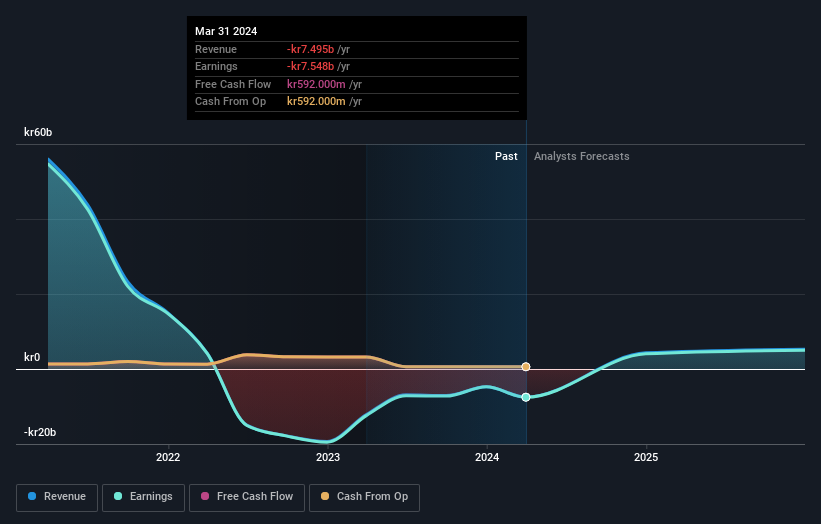Stock Analysis
- Sweden
- /
- Diversified Financial
- /
- OM:KINV B
Kinnevik AB's (STO:KINV B) 7.7% loss last week hit both individual investors who own 49% as well as institutions

Key Insights
- Kinnevik's significant individual investors ownership suggests that the key decisions are influenced by shareholders from the larger public
- A total of 22 investors have a majority stake in the company with 50% ownership
- Institutional ownership in Kinnevik is 42%
Every investor in Kinnevik AB (STO:KINV B) should be aware of the most powerful shareholder groups. And the group that holds the biggest piece of the pie are individual investors with 49% ownership. That is, the group stands to benefit the most if the stock rises (or lose the most if there is a downturn).
While institutions, who own 42% shares weren’t spared from last week’s kr2.6b market cap drop, individual investors as a group suffered the maximum losses
Let's take a closer look to see what the different types of shareholders can tell us about Kinnevik.
View our latest analysis for Kinnevik

What Does The Institutional Ownership Tell Us About Kinnevik?
Institutional investors commonly compare their own returns to the returns of a commonly followed index. So they generally do consider buying larger companies that are included in the relevant benchmark index.
Kinnevik already has institutions on the share registry. Indeed, they own a respectable stake in the company. This implies the analysts working for those institutions have looked at the stock and they like it. But just like anyone else, they could be wrong. If multiple institutions change their view on a stock at the same time, you could see the share price drop fast. It's therefore worth looking at Kinnevik's earnings history below. Of course, the future is what really matters.

Hedge funds don't have many shares in Kinnevik. Our data shows that Baillie Gifford & Co. is the largest shareholder with 11% of shares outstanding. Spiltan & Pelaro Fonder AB is the second largest shareholder owning 6.0% of common stock, and AMF Fonder AB holds about 4.8% of the company stock.
After doing some more digging, we found that the top 22 have the combined ownership of 50% in the company, suggesting that no single shareholder has significant control over the company.
While it makes sense to study institutional ownership data for a company, it also makes sense to study analyst sentiments to know which way the wind is blowing. While there is some analyst coverage, the company is probably not widely covered. So it could gain more attention, down the track.
Insider Ownership Of Kinnevik
The definition of company insiders can be subjective and does vary between jurisdictions. Our data reflects individual insiders, capturing board members at the very least. Management ultimately answers to the board. However, it is not uncommon for managers to be executive board members, especially if they are a founder or the CEO.
Most consider insider ownership a positive because it can indicate the board is well aligned with other shareholders. However, on some occasions too much power is concentrated within this group.
Our most recent data indicates that insiders own some shares in Kinnevik AB. This is a big company, so it is good to see this level of alignment. Insiders own kr663m worth of shares (at current prices). If you would like to explore the question of insider alignment, you can click here to see if insiders have been buying or selling.
General Public Ownership
The general public, who are usually individual investors, hold a 49% stake in Kinnevik. This size of ownership, while considerable, may not be enough to change company policy if the decision is not in sync with other large shareholders.
Private Company Ownership
It seems that Private Companies own 6.6%, of the Kinnevik stock. It might be worth looking deeper into this. If related parties, such as insiders, have an interest in one of these private companies, that should be disclosed in the annual report. Private companies may also have a strategic interest in the company.
Next Steps:
It's always worth thinking about the different groups who own shares in a company. But to understand Kinnevik better, we need to consider many other factors. Take risks for example - Kinnevik has 1 warning sign we think you should be aware of.
If you would prefer discover what analysts are predicting in terms of future growth, do not miss this free report on analyst forecasts.
NB: Figures in this article are calculated using data from the last twelve months, which refer to the 12-month period ending on the last date of the month the financial statement is dated. This may not be consistent with full year annual report figures.
Valuation is complex, but we're helping make it simple.
Find out whether Kinnevik is potentially over or undervalued by checking out our comprehensive analysis, which includes fair value estimates, risks and warnings, dividends, insider transactions and financial health.
View the Free AnalysisHave feedback on this article? Concerned about the content? Get in touch with us directly. Alternatively, email editorial-team (at) simplywallst.com.
This article by Simply Wall St is general in nature. We provide commentary based on historical data and analyst forecasts only using an unbiased methodology and our articles are not intended to be financial advice. It does not constitute a recommendation to buy or sell any stock, and does not take account of your objectives, or your financial situation. We aim to bring you long-term focused analysis driven by fundamental data. Note that our analysis may not factor in the latest price-sensitive company announcements or qualitative material. Simply Wall St has no position in any stocks mentioned.
About OM:KINV B
Kinnevik
Kinnevik AB is a venture capital firm specializing in investments in early to late venture and growth capital.
High growth potential with mediocre balance sheet.

